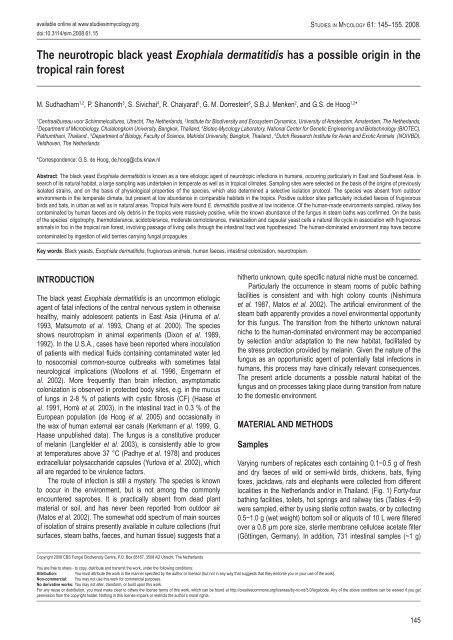You also want an ePaper? Increase the reach of your titles
YUMPU automatically turns print PDFs into web optimized ePapers that Google loves.
available online at www.studiesinmycology.orgdoi:10.3114/sim.2008.61.15St u d i es in My c o l o g y 61: 145–155. 2008.The neurotropic black yeast Exophiala dermatitidis has a possible origin in thetropical rain forestM. Sudhadham 1,2 , P. Sihanonth 3 , S. Sivichai 4 , R. Chaiyarat 5 , G. M. Dorrestein 6 , S.B.J. Menken 2 , and G.S. de Hoog 1,2 *1Centraalbureau voor Schimmelcultures, Utrecht, The Netherlands, 2 Institute for Biodiversity and Ecosystem Dynamics, University of Amsterdam, Amsterdam, The Netherlands,3Department of Microbiology, Chulalongkorn University, Bangkok, Thailand, 4 Biotec-Mycology Laboratory, National Center for Genetic Engineering and Biotechnology (BIOTEC),Pathumthani, Thailand., 5 Department of Biology, Faculty of Science, Mahidol University, Bangkok, Thailand , 6 Dutch Research Institute for Avian and Exotic Animals (NOIVBD),Veldhoven, The Netherlands*Correspondence: G.S. de Hoog, de.hoog@cbs.knaw.nlAbstract: The black yeast Exophiala dermatitidis is known as a rare etiologic agent of neurotropic infections in humans, occurring particularly in East and Southeast Asia. Insearch of its natural habitat, a large sampling was undertaken in temperate as well as in tropical climates. Sampling sites were selected on the basis of the origins of previouslyisolated strains, and on the basis of physiological properties of the species, which also determined a selective isolation protocol. The species was absent from outdoorenvironments in the temperate climate, but present at low abundance in comparable habitats in the tropics. Positive outdoor sites particularly included faeces of frugivorousbirds and bats, in urban as well as in natural areas. Tropical fruits were found E. dermatitidis positive at low incidence. Of the human-made environments sampled, railway tiescontaminated by human faeces and oily debris in the tropics were massively positive, while the known abundance of the fungus in steam baths was confirmed. On the basisof the species’ oligotrophy, thermotolerance, acidotolerance, moderate osmotolerance, melanization and capsular yeast cells a natural life cycle in association with frugivorousanimals in foci in the tropical rain forest, involving passage of living cells through the intestinal tract was hypothesized. The human-dominated environment may have becomecontaminated by ingestion of wild berries carrying <strong>fungal</strong> propagulesKey words: <strong>Black</strong> yeasts, Exophiala dermatitidis, frugivorous animals, human faeces, intestinal colonization, neurotropism.INTRODUCTIONThe black yeast Exophiala dermatitidis is an uncommon etiologicagent of fatal infections of the central nervous system in otherwisehealthy, mainly adolescent patients in East Asia (Hiruma et al.1993, Matsumoto et al. 1993, Chang et al. 2000). The speciesshows neurotropism in animal experiments (Dixon et al. 1989,1992). In the U.S.A., cases have been reported where inoculationof patients with medical fluids containing contaminated water ledto nosocomial common-source outbreaks with sometimes fatalneurological implications (Woollons et al. 1996, Engemann etal. 2002). More frequently than brain infection, asymptomaticcolonization is observed in protected body sites, e.g. in the mucusof lungs in 2-8 % of patients with cystic fibrosis (CF) (Haase etal. 1991, Horré et al. 2003), in the intestinal tract in 0.3 % of theEuropean population (de Hoog et al. 2005) and occasionally inthe wax of human external ear canals (Kerkmann et al. 1999, G.Haase unpublished data). The fungus is a constitutive producerof melanin (Langfelder et al. 2003), is consistently able to growat temperatures above 37 °C (Padhye et al. 1978) and producesextracellular polysaccharide capsules (Yurlova et al. 2002), whichall are regarded to be virulence factors.The route of infection is still a mystery. The species is knownto occur in the environment, but is not among the commonlyencountered saprobes. It is practically absent from dead plantmaterial or soil, and has never been reported from outdoor air(Matos et al. 2002). The somewhat odd spectrum of main sourcesof isolation of strains presently available in culture collections (fruitsurfaces, steam baths, faeces, and human tissue) suggests that ahitherto unknown, quite specific natural niche must be concerned.Particularly the occurrence in steam rooms of public bathingfacilities is consistent and with high colony counts (Nishimuraet al. 1987, Matos et al. 2002). The artificial environment of thesteam bath apparently provides a novel environmental opportunityfor this fungus. The transition from the hitherto unknown naturalniche to the human-dominated environment may be accompaniedby selection and/or adaptation to the new habitat, facilitated bythe stress protection provided by melanin. Given the nature of thefungus as an opportunistic agent of potentially fatal infections inhumans, this process may have clinically relevant consequences.The present article documents a possible natural habitat of thefungus and on processes taking place during transition from natureto the domestic environment.MATERIAL AND METHODSSamplesVarying numbers of replicates each containing 0.1−0.5 g of freshand dry faeces of wild or semi-wild birds, chickens, bats, flyingfoxes, jackdaws, rats and elephants were collected from differentlocalities in the Netherlands and/or in Thailand. (Fig. 1) Forty-fourbathing facilities, toilets, hot springs and railway ties (Tables 4−9)were sampled, either by using sterile cotton swabs, or by collecting0.5−1.0 g (wet weight) bottom soil or aliquots of 10 L were filteredover a 0.8 µm pore size, sterile membrane cellulose acetate filter(Göttingen, Germany). In addition, 731 intestinal samples (~1 g)Copyright 2008 <strong>CBS</strong> Fungal Biodiversity Centre, P.O. Box 85167, 3508 AD Utrecht, The Netherlands.You are free to share - to copy, distribute and transmit the work, under the following conditions:Attribution:You must attribute the work in the manner specified by the author or licensor (but not in any way that suggests that they endorse you or your use of the work).Non-commercial: You may not use this work for commercial purposes.No derivative works: You may not alter, transform, or build upon this work.For any reuse or distribution, you must make clear to others the license terms of this work, which can be found at http://creativecommons.org/licenses/by-nc-nd/3.0/legalcode. Any of the above conditions can be waived if you getpermission from the copyright holder. Nothing in this license impairs or restricts the author’s moral rights.145
















